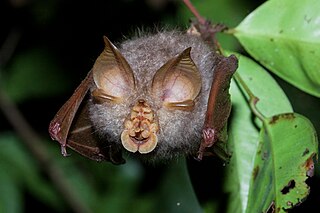
Besleria is a genus of ca. 200 species of large herbs and soft-stemmed subshrubs or shrubs in the flowering plant family Gesneriaceae. They occur in Central America, South America, and the West Indies.

Kemp's gerbil is a species of rodent. Mammal Species of the World considers G. kempi and G. gambianus to be synonyms, however the IUCN has assessed each taxon as were they different species.

The lesser woolly horseshoe bat, also called Beddome's horseshoe bat, is a species of bat in the family Rhinolophidae. It is found in India and Sri Lanka. Its natural habitats are subtropical or tropical moist lowland forests, caves, and urban areas. It is threatened by habitat loss.

The lesser woolly horseshoe bat is a species of bat in the family Rhinolophidae. It is found in Brunei, Indonesia, and Malaysia. It is assessed as near-threatened by the IUCN.

The trefoil horseshoe bat is a species of bat in the family Rhinolophidae. It is found in Brunei, India, Indonesia, Malaysia, Myanmar, Singapore, and Thailand. In Borneo locally common up to 1,800m, including mangroves.

Gasteranthus atratus is a species of plant in the family Gesneriaceae. It is endemic to Ecuador. Its natural habitats are subtropical or tropical moist lowland forests and subtropical or tropical moist montane forests.
Gasteranthus carinatus is a species of plant in the family Gesneriaceae. It is endemic to Ecuador. Its natural habitats are subtropical or tropical moist lowland forests and subtropical or tropical moist montane forests.
Gasteranthus crispus is a species of plant in the family Gesneriaceae. It is endemic to Ecuador. Its natural habitats are subtropical or tropical moist lowland forests and subtropical or tropical moist montane forests.
Gasteranthus extinctus is a species of plant in the family Gesneriaceae. It is endemic to Ecuador. Its natural habitat is subtropical or tropical moist montane forests.
Gasteranthus imbaburensis is a species of plant in the family Gesneriaceae. It is endemic to Ecuador. Its natural habitat is subtropical or tropical moist montane forests.
Gasteranthus lateralis is a species of plant in the family Gesneriaceae. It is endemic to Ecuador. Its natural habitat is subtropical or tropical moist montane forests.
Gasteranthus macrocalyx is a species of plant in the family Gesneriaceae. It is endemic to Ecuador. Its natural habitat is subtropical or tropical moist montane forests.
Gasteranthus mutabilis is a species of plant in the family Gesneriaceae. It is endemic to Ecuador. Its natural habitat is subtropical or tropical moist montane forests.
Gasteranthus orientandinus is a species of plant in the family Gesneriaceae. It is endemic to Ecuador. Its natural habitat is subtropical or tropical moist montane forests.
Gasteranthus otongensis is a species of plant in the family Gesneriaceae. It is endemic to Ecuador. Its natural habitat is subtropical or tropical moist montane forests.
Gasteranthus perennis is a species of plant in the family Gesneriaceae. It is endemic to Ecuador. Its natural habitat is subtropical or tropical moist montane forests.

Gasteranthus tenellus is a species of plant in the family Gesneriaceae. It is endemic to Ecuador. Its natural habitats are subtropical or tropical moist lowland forests and subtropical or tropical moist montane forests.
Gasteranthus ternatus is a species of plant in the family Gesneriaceae. It is endemic to Ecuador. Its natural habitat is subtropical or tropical moist montane forests.
Gasteranthus timidus is a species of plant in the family Gesneriaceae. It is endemic to Ecuador. Its natural habitat is subtropical or tropical moist lowland forests.

The World's 25 Most Endangered Primates is a list of highly endangered primate species selected and published by the International Union for Conservation of Nature (IUCN) Species Survival Commission (SSC) Primate Specialist Group (PSG), the International Primatological Society (IPS), Global Wildlife Conservation (GWC), and Bristol Zoological Society (BZS). The IUCN/SSC PSG worked with Conservation International (CI) to start the list in 2000, but in 2002, during the 19th Congress of the International Primatological Society, primatologists reviewed and debated the list, resulting in the 2002–2004 revision and the endorsement of the IPS. The publication was a joint project between the three conservation organizations until the 2012–2014 list when BZS was added as a publisher. The 2018–2020 list was the first time Conservation International was not among the publishers, replaced instead by GWC. The list has been revised every two years following the biannual Congress of the IPS. Starting with the 2004–2006 report, the title changed to "Primates in Peril: The World's 25 Most Endangered Primates". That same year, the list began to provide information about each species, including their conservation status and the threats they face in the wild. The species text is written in collaboration with experts from the field, with 60 people contributing to the 2006–2008 report and 85 people contributing to the 2008–2010 report. The 2004–2006 and 2006–2008 reports were published in the IUCN/SSC PSG journal Primate Conservation,, since then they have been published as independent publications.








